Spas and hot tubs are fairly self-regulating, and don’t require a major time investment to maintain.
However, to keep your spa in top condition and looking good, you do need to do some spring cleaning from time to time.
My technique is to drain half the spa water and refill every 4 months, with a deep cleaning every third interval, or once per year.
Here are some tips on how to deep clean your hot tub.
Step One: Flush The Pipes
Everyone knows how a toilet will grow a gross film if it’s not used (flushed) often, and it’s the same for spas and hot tubs. The inside of pipes can become coated with a slick film that builds up along edges of pipe and air fittings.
Low-flow circulation pumps often don’t provide enough force to prevent bacteria build-up inside of pipes, filters and fittings.
Causes of biofilm in spas include those that have had mechanical downtime or extended power outages, or temporary draining and standing empty. Poor water balance or sanitation slip-ups also allow bacteria to create clumpy communities, which protect themselves with a slick, slimy surface.
Biofilm is hard to prevent, even in well-maintained spas and hot tubs. The best way to handle it is to use a spa flush product regularly. Chlorine or bromine can’t get past the greasy layer that protects biofilm.
Use a product like System Flush, Jet Clean or Swirl Away to remove oils, organics, dirt and minerals, where biofilm bacteria make a home.
This is the first step, because it’s done before draining the spa. Recommended once per year, or before draining a stagnant spa – one that has not been filtered for several days or longer. Add the solution and allow to circulate overnight, following label directions closely.
Step Two: Drain The Spa
After a flush, it’s time to drain out the water in the tub. A small sump pump can do it in about 20 minutes, or you can let gravity do the work by attaching a hose to the drain spigot on the spa.
Spa water is fine water for the lawn or plants, as long as sanitizer or algaecide levels are not high.
To be safe, move the drain hose often, or run it to a storm drain.
For stagnant spas, or tubs that have sat unfiltered and untreated, use the Shop Vac to blow out the pipes with forced air (switch the hose to convert from vacuum to blower).
This can dislodge any remaining gunk that is still in the pipes.
Place the hose over returns, skimmer and drain ports, to force air in many directions.
If your spa has a forced air blower, turn it on to force remaining water out of the pipes. For seat or floor air jets, lay towels over the seat/floor before turning on the blower, to soak up the water.
Getting out the last bit of water can be tricky, a wet/dry vac comes in handy, or a large sponge and a bucket.
Step Three: Clean The Spa
To retain the luster and protect the spa surface from UV rays and chemical problems, it’s recommended by spa manufacturers to clean the spa interior surfaces after draining. Be very careful not to use household cleaners, which can harm spa surfaces and contaminate spa water.
Harsh spray cleaners or cream cleansers can seep into air holes and cause a lot of problems. Use only natural spa cleaners like Citra-Bright to clean acrylic spas. To water-proof your spa, go the extra mile after cleaning and spray on Fast Gloss to protect your spa with a thin layer of silicone.
Spa Cover cleaning is also recommended, to extend the lifespan of a spa cover. The underside is usually not treated, but if your cover is smelly, a 10% bleach solution can be sprayed on the underside, to combat a mildew odor.
The top a spa cover however, needs regular care to keep the vinyl supple and strong. Use a spa cover cleaner, followed by a vinyl conditioner, at least once per year to stop damage from sun, snow and rain.
Spa Pillows should also be removed and cleaned with mild soap and water. Manufacturers recommend that spa pillows be removed and stored if the spa is not used regularly, because of the high temperatures and chemical effects. You can protect spa pillows with a Fast Gloss treatment.
Spa Filters are cleaned with a garden hose, from top to bottom, to rinse out dirt and debris. However, even strong pressure won’t remove mineral deposits or oily grime.
To really clean a spa filter, soak the cartridge overnight in a spa filter cleaner to remove oils, grime (dirt+oil), and mineral deposits from hard water.
Or, it may be better to replace spa cartridges that are near the end of a useful life (18-24 months).
Step Four: Refill And Balance
Manufacturers recommend that you place the fill hose into the skimmer hole or filter hole, which is a way to avoid an air lock after filling the spa. An air lock occurs when air is trapped in the pipes, especially in front of the pump.
If your fill water comes from an untreated source, or contains high levels of metals and minerals, or has a bad smell or color – use a pre-filter on the end of the garden hose to trap contaminants and impurities.
When the spa is full (don’t overfill it!) – test the water pH, Alkalinity, Calcium Hardness levels and adjust if needed. Add a shock treatment to the spa, using MPS or chlorine granules, just to be sure the water is sanitary.
After a refill, balance, and shocking, let the spa circulate and filter for several hours, or overnight – running the heater to bring the water temp back up.

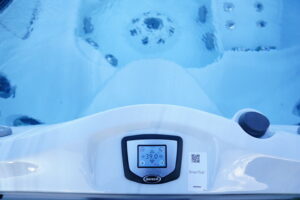
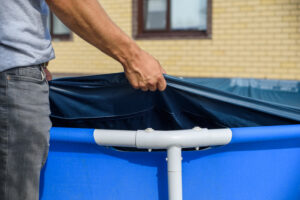
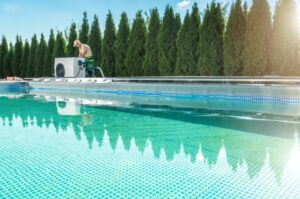
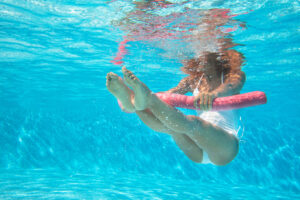

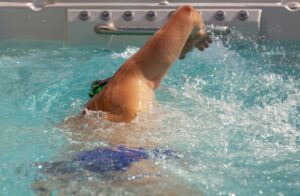

 by
by 